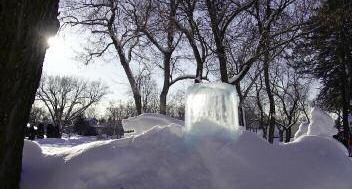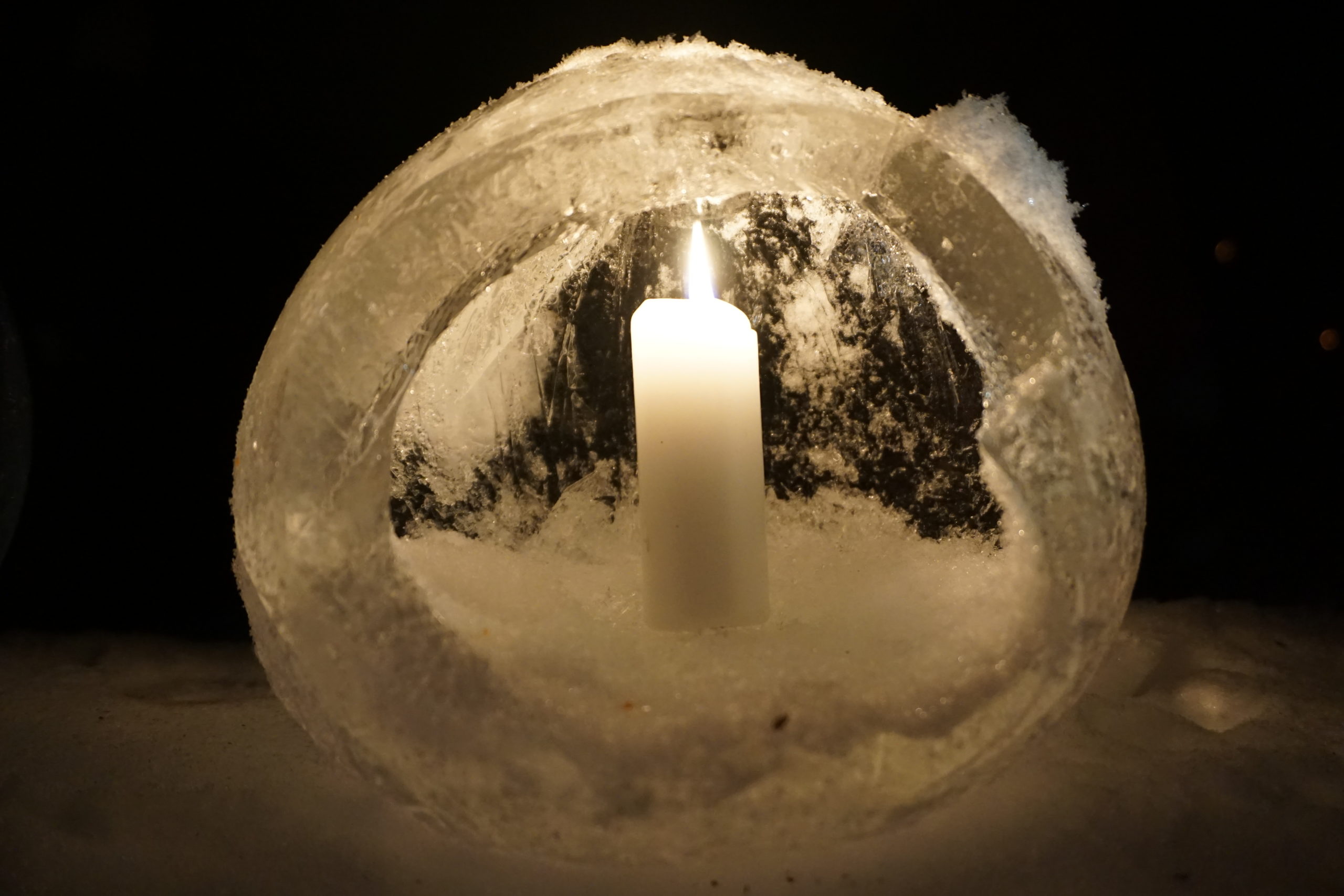This article originally appeared in the 2006 Ely Winter Times.
It is a cold December night in a garage near Ely. Predictions are for twenty-below. Two figures trudge between the house and the garage, lugging heavy pails, taking advantage of these perfect conditions to work on the project that is their gift to Ely each winter. A gift of light in the middle of a dark season. A gift of 84 icy, magical, sparkling spots to illuminate the pathways, trees, and snow sculptures of a wintery Whiteside Park. A gift from a couple who aren’t as young as they once were, but for whom giving is as much a part of who they are as their graying hair, their friendships with neighbors, and their dream a retirement home on the lake.
Frank and Retta Fifo began vacationing in Ely in 1972, and as many Ely visitors do, they immediately knew it was where they wanted to live, the sooner the better. In 1987 they bought their “piece of heaven” on Farm Lake. With an early retirement in 1991, they moved into a pop-up camper on the property, built a 24’ x 24’ garage to serve as temporary kitchen and closet, used the lake as their bathtub, and began helping with the construction of the dream home they had designed. Many fond memories were built along with the home, until that memorable Halloween snowstorm when wet, heavy snow nearly collapsed their camper. After that they stayed in a breezy rental cabin, snuggling in bed to keep warm and listening to the Twins win the World Series. A memorable time, indeed!
On December 7, they moved into their dream come true. Neighbors Berna and Angie Seliskar brought a gift of two ice candles they had made in ice cream pails. These luminaries graced the Fifo front porch through the holidays and well into the new year. Fascinated with their simple beauty, and thinking that bigger might be better, Frank used 5-gallon pails to make another pair of candle holders that lasted until spring.
Accustomed to the rewards of volunteerism, Frank and Retta had become active in Ely organizations as soon as they moved into the community. Both were First Responders with the Town of Morse. Both are now caregivers with the Northwoods Hospice Respite program. Retta is an active member of Heart of the Woods quilters (see article in Ely Summer Times 2006). Frank worked hard to get funding for defibrillators that would be kept at key locations for a fast response to heart attacks in Ely’s rural areas. Throughout the fall, the Fifo home is filled with the smells of chocolate and confections as they make pounds and pounds of candies for holiday gifts to the hospital, clinic, and other Ely service organizations. And as soon as it’s cold enough, their garage is full of plastic pails serving as molds for the icy luminaries that will decorate Whiteside Park come February.
The idea came to Frank one night as he thought about the annual Voyageur Winter Festival and wanted to find something to contribute that would add a new look. The sculptures, as wonderful as they are, had been around long enough that the novelty had worn off, although the creativity always brings a renewed sense of drama each year. Frank wanted to add something extra special that would complement the artistry of the sculptures. What could be better than making the park look even prettier at night? He approached Festival Artistic Director Mike Sinesio who immediately gave his enthusiastic approval: “Go for it! You’re a committee of one. ” Frank soon enlisted Retta’s aid, and for five years they have been a committee of two.
Frank and Retta start making luminaries as soon as the weather is cold enough. “It’s all about the temperature, ” Frank says. “In 2004 we had 40 made by Christmas, and it was a good thing because January was so warm we couldn’t have made enough. ”
The first year, they made 50, but didn’t feel it was enough to create the special fairyland effect they were hoping for. Since then, they have made 80 to 90, and have found that 84 is just about right. They like to place several luminaries near each group of sculptures, along the walkways near the smaller amateur carvings, and on the high banks where they can be seen from the streets.

It seems like a lot of dedication to make that many candle holders and place them carefully around the park, but that is just the beginning. The hardest, coldest work is lighting the candles every night. Beginning on the Friday night at the start of the Winter Festival and continuing for nine more nights, Frank and Retta come to town at dusk and spend about an hour lighting candles and placing them into their icy holders, transforming the park’s chilling dark to a welcoming glow. The 12-hour votive candles illuminate the park all evening and far into the night. Not many are watching when they start to sputter out at about 3am. Frank and Retta have learned through bitter cold experience that there’s no use making the effort if the wind is 15 mph or more. The candles just blow out.
“The hard part,” Frank explains, “is that you can’t wear your gloves while lighting the candles because gloves make your hands too bulky to reach down into the hole. So our hands get pretty cold by the end.”
But the rewards come every night, too. As the candles begin to brighten the winter scene, people begin to walk the paths – attracted like summer moths to a porch light. And without fail, someone expresses profound appreciation for the beauty that Frank and Retta have brought to the park.

Sometimes letters and cards arrive. Months later, people are still stopping this dedicated couple in the grocery store to express their gratitude.
It’s a gift that goes beyond ten nights of pretty lights. It’s a gift that tells visitors that this is a town where people like to share their talents with the community. It’s a gift that teaches our children that beauty is worth the effort, especially when it’s shared. It’s a gift that reminds each of us that doing something for someone else – even for people we don’t know – is rewarding. And Frank and Retta are a wonderful reminder that retirement, far from being the end of our contribution to our community, can be the beginning of a whole new way of making our town a great place to live.
Make Your Own Luminaries

The Ely Winter Festival candle holders are made with 5-gallon plastic pails, but you can use smaller containers. Thinner plastic is more likely to crack in the cold, making such containers less reusable. Smaller luminaries will freeze faster, but will also melt faster in warm weather. These directions are for the 5-gallon pails.
Fill the pail with water to within an inch of the top and leave it on a level spot in the cold. 20 below is ideal weather, as the water will freeze to the right thickness overnight. At 40 below, the pail will crack. At 10-15 above, the water will take 2-3 days to freeze.
To add color, mix 2 tablespoons of latex paint into one quart of water. Stir one tablespoon of this mixture into each 5-gallon pail of water. Too much paint will create an opaque ice and the candle won’t shine through. J&L Hardware has 2-ounce bottles of craft paints that work well.
Gauging the thickness of the ice along the sides of the pail may take some practice. Ideally, the wall of the luminary will be about two inches thick. One-inch thick walls will work, but will melt fast on a sunny day. The ice on the top of the pail may be much thicker than two inches, but the ice at the bottom of the pail will be thinner.
When the ice is the right thickness, take the pail into a warm place and let it sit, or run warm water over the outside of the pail until the ice is melted enough to slide out of the pail.
Turn the ice chunk so that it is upside down. The thinner ice that was at the bottom of the pail is now the top of the luminary. Use a sheetrock saw or camp saw to cut a hole through this end to the water trapped inside and pour the water out. This creates the hole for the candle. Be sure the hole is large enough to reach in to light the candle. If the other end – now the bottom – is too lumpy for the luminary to sit securely, saw it flat.
Add your votive candle, and you have a luminary that will last until warm temperatures or sunshine melt it.
Frank and Retta use these as inside decorations by placing them in pans and occasionally removing the melted water with a turkey baster.

